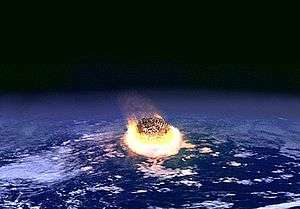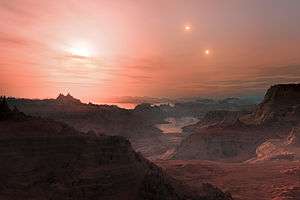Sutter's Mill meteorite
| Sutter's Mill meteorite | |
|---|---|
|
Fragments of the Sutter's Mill meteorite obtained from Henningsen Lotus Park, Lotus, California.[1] | |
| Type | Chondrite |
| Class | Carbonaceous chondrite |
| Group | CM2 |
| Country | USA |
| Region | California |
| Coordinates |
37°36′N 120°30′W / 37.6°N 120.5°WCoordinates: 37°36′N 120°30′W / 37.6°N 120.5°W (airburst)[2] 38°48’14"N, 120°54’29"W[3] |
| Observed fall | Yes |
| Fall date | 22 April 2012 |
| Found date | 24 April 2012 |
| TKW | 952.7 grams[4] |
| Strewn field | Yes |
 SM33 (8.5 g) fragment with a small part of the fusion crust missing[5] | |
The Sutter's Mill meteorite is a carbonaceous chondrite which entered the Earth's atmosphere and broke up at about 07:51 Pacific time on April 22, 2012.[6][7] The name comes from the Sutter's Mill, the California Gold Rush site, near which some pieces were recovered.[3][8] This was the largest meteoroid impact over land since asteroid 2008 TC3. Meteor astronomer Peter Jenniskens assigned SM numbers to each meteorite, with the documented find location preserving information about where a given meteorite was located in the impacting meteoroid. As of May 2014, 79 fragments have been publicly documented with a find location. The largest (SM53) weighs 205 grams,[4][9] and the second largest (SM50) weighs 42 grams.[9]
The meteorite was found to contain some of the oldest material in the solar system.[10][11][12] Two 10-micron diamond grains (xenoliths) were found in the meteorite recovered before the rain fell.[13] In primitive meteorites like Sutter's Mill, some grains survive from what existed in the cloud of gas, dust and ice that formed the solar system.
History
During the 2012 Lyrids meteor shower, a bolide and sonic boom rattled buildings in California and Nevada in daylight conditions in the early morning at 07:51 PDT on 22 April 2012.[14] The bolide air burst was caused by a random meteoroid, not a member of the Lyrids shower.[15] The bolide was so bright that witnesses were seeing spots afterward.[16] The falling meteorites were detected by weather radar over an area centered on the Sutter's Mill site in Coloma, between Auburn, California, and Placerville, California.[7]
Robert Ward found a small CM chondrite fragment in the Henningsen Lotus Park just west of Coloma, CA on 24 April 2012.[17] Later that day, Peter Jenniskens found a crushed 4 g meteorite in the parking lot of that same park and Brien Cook found a 5 g meteorite off Petersen Road in Lotus. These were the only meteorites found before rain hit the area on 25 April.
On 1 May 2012, the James W. Marshall Gold Discovery State Historic Park's Ranger Suzie Matin discovered two pieces of the meteorite (SM14 @ 11.5 grams) in her front yard. The park contains what is now known as Sutter's Mill (site).[18] On 3 May 2012 scientists with the Ames Research Center and the SETI Institute utilized an airship to search the strewn field for the impact scars of kg-sized meteorites, but it is now understood that the high entry speed prevented the survival of meteorites as large as found in the Murchison meteorite fall.[19] Ground-based searches resulted in the additional recovery of two pristinely collected meteorites (SM12 and SM67) for scientific study.
Comparisons
This is the third witnessed meteorite fall in California, following Red Canyon Lake on 11 August 2007 and San Juan Capistrano on 15 March 1973, while a few months after this event the Novato meteorite fell on 17 October 2012.[20]
A consortium of over 50 scientists investigated the circumstances of the impact and the properties of the meteorites.[9] The event was recorded by two infrasound monitoring stations of the Comprehensive Nuclear-Test-Ban Treaty Organization’s International Monitoring System.[21] The preliminary analysis are indicative of energy yield of approximately 4 kilotons of TNT equivalent.[21] Hiroshima's "Little Boy" had a yield of about 16 kt. The meteoroid was probably between the size of a dish washer[22] and a mini van.[23] The air burst had approximate coordinates of 37°36′N 120°30′W / 37.6°N 120.5°W.[2]
Based on the infrasound signal and the brightness of the fireball in photographs and two video records, the incoming meteoroid was estimated to have been 2–4 meters in diameter. Before entry in Earth's atmosphere, the meteoroid probably had an absolute magnitude (H) of roughly 31.[24] The meteoroid entered at a record speed of 28.6 ± 0.7 km/s, the fastest fireball on record from which meteorites were later recovered.[9] It broke apart at an altitude of 48 km, the highest breakup event on record resulting in meteorites on the ground.
Before entry, the meteoroid moved on an eccentric orbit, stretching from just inside the orbit of Jupiter to the orbit of Mercury. The orbit had a shallow inclination and an orbital period suggesting that this meteoroid originated in the 3:1 mean motion resonance with Jupiter. The CM chondrite Maribo moved on a similar orbit, but rotated by 120 degrees in the direction of the line of apsides. The asteroid family that is the source region of CM chondrite-type meteorites is now thought to be located close to the 3:1 mean motion resonance, in low-inclined orbits, and may be the Eulalia asteroid family.[9]
The meteorite type is similar to that of the 1969 Murchison meteorite in Australia. Unlike Muchison, Sutter's Mill shows clear brecciation: fragments of CM lithologies with different aqueous alteration and thermal processing histories are embedded in a fine grained CM matrix material. The Sutter's Mill meteorite originated from near the surface of its parent body. As a whole, Sutter's Mill is harder than Murchison.[9]
The pre-rain collected meteorite SM2 was found to contain the mineral oldhamite (CaS), a mineral that reacts readily with water vapor. This xenolithic material may have come from enstatite chondrites impacting on the surface of the CM chondrite parent body in the past.[9]
The Sutter's Mill meteorite is used to test sample collection and analysis procedures for NASA's OSIRIS-REx sample return mission.[9]
Examples
- SM39 (2.5 g)
 Mike Miller's SM49 (5.9 g)
Mike Miller's SM49 (5.9 g)
See also
References
- ↑ "APOD: 2012 April 28 - Sutter's Mill Meteorite". APOD. NASA & MTU. 2012-04-28. Retrieved 2012-04-28.
- 1 2 Bill Cooke of NASA Meteoroid Environments Office (Apr 23, 2012). "(meteorobs) Fwd: large bolide over California/Nevada". Retrieved 2012-04-23.
- 1 2 "Sutter's Mill". Lunar and Planetary Institute: Meteoritical Bulletin Database. Retrieved 2012-05-22.
- 1 2 Mike Gilmer (June 27, 2012). "Sutter's Mill California Meteorite Fall - Tally of Known Finds". Retrieved 2012-07-07.
- ↑ Ruben Garcia. "Sutter Mill Meteorite Hunt". Mr-Meteorite. Retrieved 2012-05-09.
- ↑ Ian O'Neill (2012-04-23). "Minivan-sized Asteroid Exploded Over California". Discovery News. Retrieved 2012-04-28.
- 1 2 Marc Fries (mfries01) (23 April 2012). "Coloma, CA 22 Apr 2012 1452 UTC". Radar Obs of Meteor Events. Archived from the original on June 17, 2012. Retrieved 2012-04-25.
- ↑ Franck Marchis (April 25, 2012). "Fragments of the daylight meteor found in California". Cosmic Diary. Retrieved 2012-04-26.
- 1 2 3 4 5 6 7 8 Peter Jenniskens. "The Impact and Recovery of the Sutter's Mill Meteorite". SETI Institute. Retrieved 2012-07-07.
- ↑ http://www.sciencenews.org/view/generic/id/347199/description/California_meteorite_a_scientific_gold_mine
- ↑ http://www.nature.com/news/us-meteorite-was-fastest-on-record-1.12095
- ↑ http://www.businessinsider.com/one-of-the-fastest-rarest-meteorites-recovered-in-californias-gold-county-2012-12
- ↑ "NASA Scientists Find Diamonds and Other Treasures in Gold Rush Meteorite". NASA's Ames Research Center. November 7, 2014. Retrieved 2014-11-10.
- ↑ Guy Clifton (Apr 22, 2012). "Meteor shower likely cause of big boom heard throughout region". Reno Gazette-Journal. Retrieved 2012-04-22.
- ↑ Deborah Byrd (Apr 22, 2012). "Loud boom and bright fireball over California and Nevada on April 22". EarthSky. Retrieved 2012-04-22.
- ↑ Guy Clifton (Apr 23, 2012). "Local resident's photo of Sunday's meteor goes international". Reno Gazette-Journal. Retrieved 2012-04-23.
- ↑ Franck Marchis (Apr 25, 2012). "Re: {MPML} Fireball Over California/Nevada: How Big Was It?". Yahoo group: Minor Planet Mailing List (mpml). Retrieved 2012-04-25.
- ↑ "Sutter's Mill Meteor". Gold Discovery Park Association. Retrieved 2012-05-04.
- ↑ "Scientists aboard airship to search for meteorites strewn over California gold country". Washington Post. May 3, 2012. Retrieved 2012-05-04.
- ↑ Peter Jenniskens (May 25, 2009). "California Meteorite Falls". SETI Institute. Retrieved 2012-04-30.
- 1 2 Guy Clifton (Apr 23, 2012). "Scientist says sound signal from exploding meteor lasted 18 minutes". Reno Gazette-Journal. Retrieved 2012-04-23.
- ↑ "Explosion Heard in NV, CA Traced To Meteor". KTVN 2 (Reno). Apr 22, 2012. Retrieved 2012-04-23.
- ↑ "Fireball Over California/Nevada: How Big Was It?". NASA/JPL. April 24, 2012. Retrieved 2012-04-24.
- ↑ "Conversion of Absolute Magnitude to Diameter". Minor Planet Center. Retrieved 2012-05-30.
External links
| Wikimedia Commons has media related to Sutter's Mill Meteorite. |
- California Meteor Broke Speed Record for Atmospheric Entry (Scientific American December 20, 2012)
- Sutter's Mill Meteorite: a Californian Treasure Discovered by SETI/NASA Researchers (Google Hangout chat 20 December 2012)
- Jenniskens, Peter (2012). "Radar-Enabled Recovery of the Sutter's Mill Meteorite, a Carbonaceous Chondrite Regolith Breccia". Science. 338 (6114): 1538–1587. doi:10.1126/science.1227163.
- Analysis of Sutter's Mill fragments reveals organic compounds not seen in other meteorites (Phys.org : 10 Sept 2013)
- Sutter Mill Meteorite Hunt (Mr-Meteorite Ruben Garcia purchased 8.5 gram Sutter Mill Meteorite with broken fusion crust)
- Patient hunters find more meteorites from California fall (AstroBob April 29, 2012)
- Robert Wards 44 gram find
- Steve Arnold (meteorhntr) photos of 0.38g SM slice
- Greg Hupé SM19 (oriented 9.9g)
- Sutter's Mill photos at ASU (SM6, SM8, SM38, SM41, SM49) (meteorite-list)
- Video of the daylight California fireball (Phil Plait 31 May 2012)
- CAMS News blog (CAMS is an automated video surveillance of the night sky in search of meteors to validate minor showers in the IAU Working List of Meteor Showers)
- Strewn field maps:
- Coloma, CA Strewn Field Map (Marc Fries)
- Sutter Mill strewn field (Jim Wooddell)
- Interactive map: See where meteorites fell (SacBee: Last Modified: Monday, May. 7, 2012)
- Sutter Mill Meteorite Find Tally (An updated tally of Sutter Mill meteorites found - Mike Gilmer)
- Official Sutter Mill Meteorite Hunt Page - NASA/SETI (Dr. Jenniskens' Official Sutter Mill Find Data Page)



